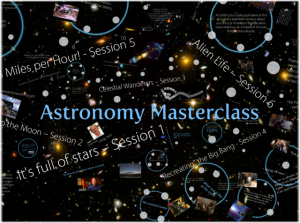It's full of stars: Difference between revisions
mNo edit summary |
mNo edit summary |
||
| Line 31: | Line 31: | ||
}} | }} | ||
[[Category:Secondary]] [[Category:Science]] | [[Category:Secondary]] [[Category:Science]] | ||
== Teacher's Notes == | == Teacher's Notes == | ||
Revision as of 16:00, 10 September 2012
Lesson idea. This session involves practical astronomy. It tells what you can expect to see through a telescope and outlines how a telescope works. This is session one of a series of 6 entitled 'Astronomy masterclass' (SC0018).
Teaching approach. Astronomy(topic) has been practiced for centuries and doesn't require expensive equipment! This first session aims to train the whole class(ta) to use a telescope and, hopefully, to provide an opportunity to engage in some active learning(ta). The lesson includes some naked-eye observations and describes how modern technology helps scientists know where to look. You can explore the scientific method(ta) and language(ta) at this point, using targeted questioning(ta)/differentiation(ta). Students may be able to engage in an inquiry(ta)-based project around this work, perhaps for homework(ta). (edit)
| Resource details | |
| Title | It's full of stars |
| Topic | [[Topics/Astronomy|Astronomy]] |
| Teaching approach | [[Teaching Approaches/Differentiation|Differentiation]], [[Teaching Approaches/Homework|Homework]], [[Teaching Approaches/Questioning|Questioning]], [[Teaching Approaches/Whole class|Whole class]], [[Teaching Approaches/Language|Language]], [[Teaching Approaches/Active learning|Active learning]], [[Teaching Approaches/Inquiry|Inquiry]], [[Teaching Approaches/Scientific method|Scientific method]] |
| Learning Objectives |
|
| Format / structure | An 18 minute narrated screencast which is part of the full, six hour 'Astronomy Masterclass'. Also supplied as a Prezi and a Acrobat file should you wish to do the presentation yourself. The Astronomy Masterclass overview tells how the resource was used. |
| Subject | [[Resources/Science|Science]] |
| Age of students / grade | [[Resources/Secondary|Secondary]], [[Resources/Year 10|Year 10]]
|
| Related ORBIT Wiki Resources | |
| Files and resources to view and download | Choice of formats:
|
Teacher's Notes
Session 1 – It’s full of stars
The title of this first session is from the last words of the movie '2001: a space odyssey'. Its main aim is to introduce students to practical astronomy (hopefully they will get to do some) and to teach them how to use telescopes safely and correctly. This is the shortest of the “lectures” as it is designed to leave some time for students to practically use scopes within the confines of a lab, or hopefully outside looking at stars. The basic flow is as follows:
- The story of Hans Lippershey and how and why Galileo is incorrectly remembered as its inventor
- A brief introduction to the mechanism of two lenses – I often get smaller groups playing with pairs of lenses or get them to look down the barrel of a large reflecting telescope such as a Meade lx200
- Warn students to be careful – video from Australia showing damage from a science experiment gone wrong
- Question – What sort of things can you see using a telescope?
- Video – Some images taken using telescopes – specifically most taken with the Hubble. These sorts of images you can never seen using a small scope in a light polluted city.
- Reasons why they can’t be seen... Too feint, too small, too much light pollution, not a big enough scope, eyes not sensitive enough, need to use a camera and a long exposure. (Heinrich Olbers is visible in the bottom of the screen for this question, he comes up in session 4 – however his paradox can be mentioned now if you like – this is the first of many cross over points between the sessions.)
- Star trails picture taken over around a 2hr exposure (from the size of the trails – full circle = 24hrs) Foreground image and star trails are NOT taken at the same time with same exposure – this has been edited. Note the “pole star” doesn’t appear to move (much)
- Zoom in – naked eye astronomy task – find Polaris using the pointers. Hit the big W of Cassiopeia and you have gone too far. Note the “pole star” is not actually that bright, and due to precession of the Earth’s Axis it will not always be on the pole.
- Introduction to Right Ascension and Declination
- Video - Introduction to software that maps the sky – Microsoft virtual telescope (free), Distant suns (iPhone app – not free) and various other programs.
- Time spent with telescopes – hopefully outside
End of session 1
Useful cloudy weather applications:
• APOD http://apod.nasa.gov/apod/astropix.html
• Virtual Telescope http://www.worldwidetelescope.org/Home.aspx
• Working out magnification using objects inside a room.

